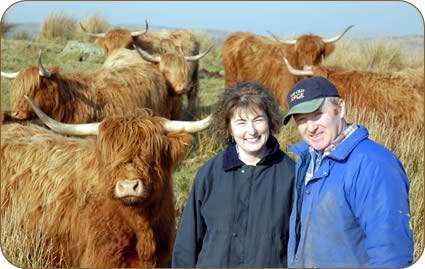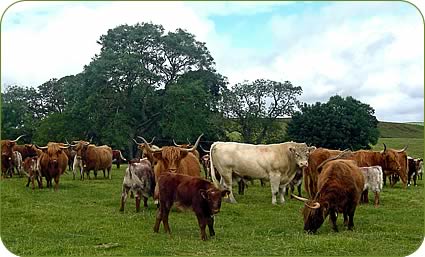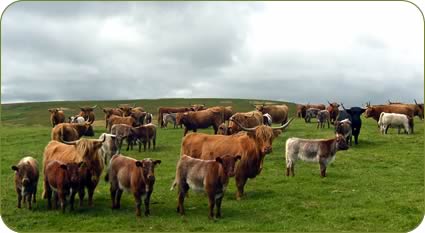Jennifer MacKenzie is an agricultural photo journalist with almost 30 year's experience. Operating from her base in Cumbria, Jennifer undertakes mainly industry-related freelance writing and photography.
Back to the Future
Traditional Breed’s Potential Role In Future Beef Production
Stratification of the beef industry and the potential role of the Whitebred Shorthorn comes under the spotlight at an on-farm open day in South West Scotland on Wednesday 27 August 2014.
Hosting the event, which is sponsored by Morrisons, are well known pedigree and commercial beef and sheep producers Neale and Janet McQuistin at High Airyolland, New Luce, Newton Stewart.
 |
Janet and Neale McQuistin |
In 2005, after EU farm support was decoupled from headage payments, the McQuistins decided to replace their traditional Angus cross suckler cows with Highland cows - a breed which fits in best with their long-term plan for the farm.
There is no cattle housing for the winter and there is plenty of rough grazing that can be utilised to good effect by the Highland cattle. At the same time they are being used to manage suitable areas on the farm for the benefit of the environment.
A small nucleus fold of Highland cows was established which has quickly mushroomed into 80 females of different ages, run alongside pedigree Beltex, Bluefaced Leicester and Scotch Mule flocks.
 |
Highland Cows running with the Whitebred Shorthorn Bull |
Now, with enough homebred females, the McQuistins have started to use the long-established traditional breed, the Whitebred Shorthorn over them - primarily a crossing bull suitable for any breed of female but principally with the Galloway to produce the Blue Grey but also the cross Highlander.
The first bull Longley Milestone was purchased from Adrian and Janice Wheelwright’s Longley herd first going to the cows in June 2012 with the Highland bull used to sweep up and provide replacements.
Neale said: “We chose to cross our Highland cattle with the Whitebred Shorthorn because of their reputation for producing a first class suckler cow that is remarkably milky and easily maintained.
“We were very pleased with our first calves off the Whitebred Shorthorn,” added Neale. “They have very good conformation, grew out well and were particularly pleasing to the eye. They have been very placid and easy to work with.
The heifers were sold straight from the farm and a batch of nine bullocks sold at Stirling market in November 2013 were 215kg and made £490 each.
 |
Highland Cows with Whitebred Shorthorn cross calves |
Morrisons has a small herd of Whitebred Shorthorns alongside one of the UK’s largest pedigree herds of Beef Shorthorns at Dumfries House in Ayrshire where, in a unique collaboration with one of the Prince of Wales’ charities, it has been running the 1,000 acre farm since 2009.
Under the supermarket’s traditional beef scheme Whitebred sired steers are eligible for the same 30p per kg premium as the Beef Shorthorn.
Morrison’s agriculture manager Andrew Loftus said: “WBSH, in our view, could become increasingly important as part of a stratified beef breeding programme, being a true maternal breed.
“The Blue Grey in particular has demonstrated impressive efficiency in SRUC trials and will play an increasingly important role in grazing marginal land.
“This is important as prime land is less likely to be available for beef production in the future.
“WBSH sired females make great suckler cows that can calve to a wide variety of terminal sires.”
At the open day as well as Whitebred cross Highland cattle, visitors will be able to see Blue Grey cows with Charolais calves and Whitebred cross Highland cows with Simmental calves.

